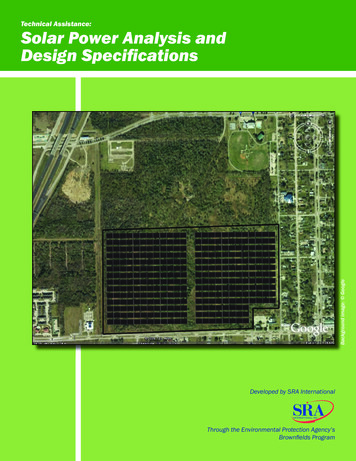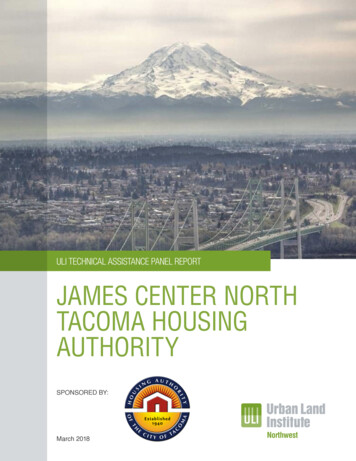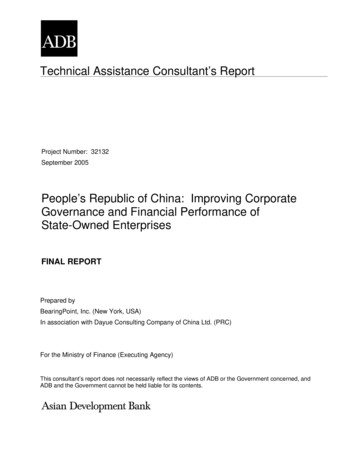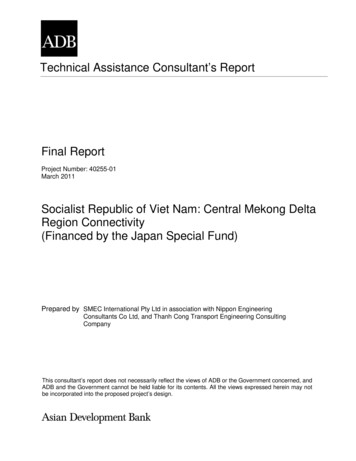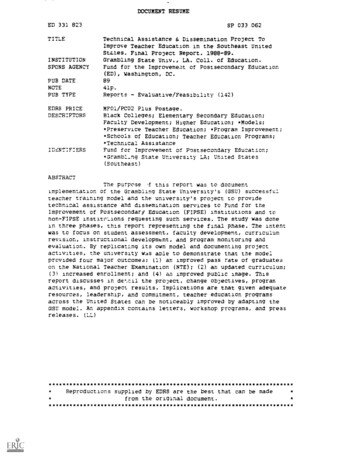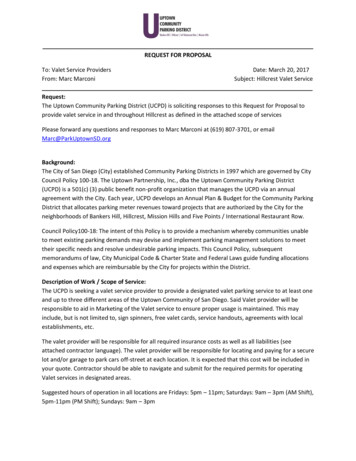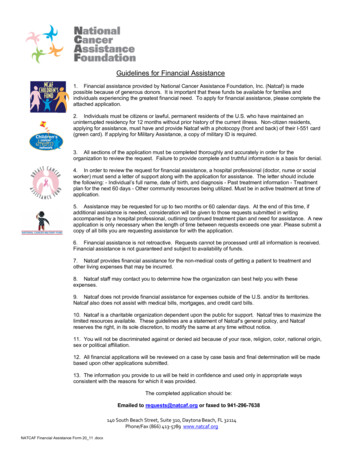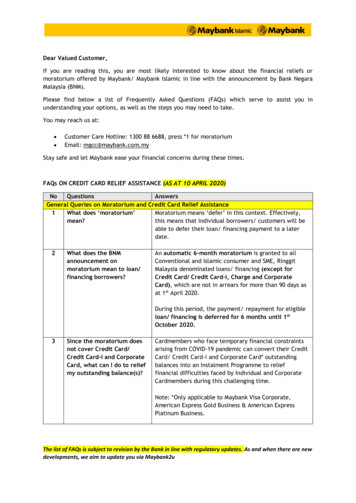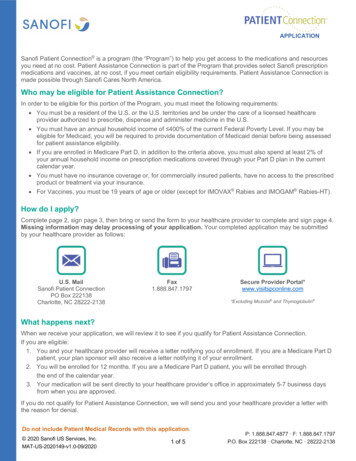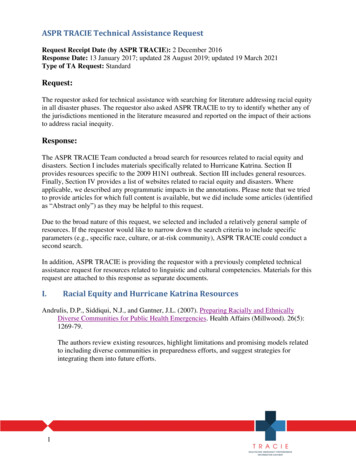
Transcription
ASPR TRACIE Technical Assistance RequestRequest Receipt Date (by ASPR TRACIE): 2 December 2016Response Date: 13 January 2017; updated 28 August 2019; updated 19 March 2021Type of TA Request: StandardRequest:The requestor asked for technical assistance with searching for literature addressing racial equityin all disaster phases. The requestor also asked ASPR TRACIE to try to identify whether any ofthe jurisdictions mentioned in the literature measured and reported on the impact of their actionsto address racial inequity.Response:The ASPR TRACIE Team conducted a broad search for resources related to racial equity anddisasters. Section I includes materials specifically related to Hurricane Katrina. Section IIprovides resources specific to the 2009 H1N1 outbreak. Section III includes general resources.Finally, Section IV provides a list of websites related to racial equity and disasters. Whereapplicable, we described any programmatic impacts in the annotations. Please note that we triedto provide articles for which full content is available, but we did include some articles (identifiedas “Abstract only”) as they may be helpful to this request.Due to the broad nature of this request, we selected and included a relatively general sample ofresources. If the requestor would like to narrow down the search criteria to include specificparameters (e.g., specific race, culture, or at-risk community), ASPR TRACIE could conduct asecond search.In addition, ASPR TRACIE is providing the requestor with a previously completed technicalassistance request for resources related to linguistic and cultural competencies. Materials for thisrequest are attached to this response as separate documents.I.Racial Equity and Hurricane Katrina ResourcesAndrulis, D.P., Siddiqui, N.J., and Gantner, J.L. (2007). Preparing Racially and EthnicallyDiverse Communities for Public Health Emergencies. Health Affairs (Millwood). 26(5):1269-79.The authors review existing resources, highlight limitations and promising models relatedto including diverse communities in preparedness efforts, and suggest strategies forintegrating them into future efforts.1
Cordasco, K.M., Eisenman, D.P., Glik, D.C., et al. (2007). "They Blew the Levee": Distrust ofAuthorities Among Hurricane Katrina Evacuees. Journal of Health Care for the Poor andUnderserved. 18(2): 277-282.The authors provide an overview of the relationship between some New Orleansresidents’ distrust of authorities (and several other factors) and their reactions toevacuation warnings and public health authorities’ advice.Impact: The authors of this study conducted interviews with 58 English-speaking adultswho were living in Louisiana prior to landfall of Hurricane Katrina and were receivingshelter in one of three Houston, TX evacuation centers at the time of the interview.Interviewees noted their distrust came from their perceived lack of competency amonggovernments official (from federal to local) and emergency workers. They also believedthat the preparations or response were performed ineffectively or slowly because of therace or socioeconomic composition of their neighborhood.Dach-Gruschow, K. and Hong, Y. (2006). The Racial Divide in Response to the Aftermath ofKatrina: A Boundary Condition for Common Ingroup Identity Model. (Abstract only.)Analyses of Social Issues and Public Policy. 6(1):125–141.Polls taken shortly after Hurricane Katrina found that that many African-Americans feltthat racism contributed to the perceived slow response. The same polls revealed thatmany Whites felt that the residents of New Orleans were partially to blame for theirpredicament. The authors examined the findings further and made recommendations forfuture preparedness and research efforts.Gabe, T., Falk, G., McCarty, M., et al. (2005). Hurricane Katrina: Social-DemographicCharacteristics of Impacted Areas. Congressional Research Service.This document provides data about areas impacted by Hurricane Katrina in 2005,including estimates of the population who were most affected and most likely displacedby the storm, in total and in each of the three affected states: Louisiana, Mississippi, andAlabama. It presents a social-demographic profile of the affected population, looking atcharacteristics such as poverty and race/ ethnicity status, homeownership, and housingstatus. Separate topics are also addressed for the elderly, children, and working-ageadults.Impact: Before the storm, the 700,000 people acutely affected by Katrina were morelikely than Americans overall to be poor; minorities (most often African-American); lesslikely to be connected to the workforce; and more likely to be educationallydisadvantaged (i.e., not having completed a high school education). Residents who wereeconomically disadvantaged or became so after the storm faced more challenges reestablishing their lives.2
Rose, D., Bodor, J.N., Rice, J.C., et al. (2011). The Effects of Hurricane Katrina on Food AccessDisparities in New Orleans. (Abstract only.) American Journal of Public Health.101(3):482-4.The authors examine disparities in New Orleans residents’ access to food beforeHurricane Katrina (2004-2005), in 2007, and in 2009. Results indicated that despite someimprovements in the “food retail landscape” since 2007, access to food for those inAfrican-American neighborhoods did not improve over time. The authors note a set ofrecommendations put forth by the New Orleans Food Policy Advisory Committee andprovide a summary of the program’s progress through the time the article was published.II.Racial Equity and H1N1 Event ResourcesDee, D.L., Bensyl, D.M., Gindler, J., et al. (2011). Racial and Ethnic Disparities inHospitalizations and Deaths Associated with 2009 Pandemic Influenza A (H1N1) VirusInfections in the United States. (Abstract only). Annals of Epidemiology. (8):623-30.The authors used various data sources to examine racial-ethnic disparities in the 2009pandemic influenza A (H1N1) illness severity and health consequences for U.S. minoritypopulations. The authors noted racial-ethnic disparities in H1N1-associated healthcareseeking behavior, hospitalizations, and pediatric deaths.Knox, R. (2009). Officials Find Swine Flu Hits Minorities Harder. National Public Radio (NPR).The author of this article discusses how certain factors (e.g., lower income, higherincidence of asthma, lower rates of vaccination) contribute to the disproportionate effectof swine flu on minorities.Impact: The author explains that many low-income parents face challenges keeping theirsick children home from school—namely not being able to take off time from work tostay home with their children. She also noted that in the Boston area, African-Americansand Hispanics were twice as likely to require hospitalization for the new H1N1 virus,primarily because they were also more likely to already have asthma, which is moreprevalent among African-Americans and Latinos.Plough, A., Bristow, B., Fielding, J., et al. (2011). Pandemics and Health Equity: LessonsLearned from the H1N1 Response in Los Angeles County. (Abstract only.) Journal ofPublic Health Management and Practice. 17(1): 20-7.The authors examine data from an H1N1 mass vaccination clinic provided by the LosAngeles County Department of Public Health in 2009. African American residentsreported the lowest vaccination rate, followed by white residents. The authors note thatinformal community messaging was running counter to “official” messaging that washighlighting equity in vaccination access.3
Quinn, S.C., Kumar, S., Freimuth, V.S., et al. (2011). Racial Disparities in Exposure,Susceptibility, and Access to Health Care in the US H1N1 Influenza Pandemic. AmericanJournal of Public Health. 101(2):285-93.The authors of this study examined racial disparities in H1N1 exposure, susceptibility toH1N1 complications, and access to healthcare during the 2009 H1N1 influenzapandemic. They noted disparities in the risks of exposure, susceptibility (particularly tosevere disease), and access to healthcare.III.General ResourcesAmerican Medical Association (n.d.). Reducing Disparities in Health Care. (Accessed8/29/2019.)This webpage outlines the American Medical Association’s work to reduce healthcaredisparities, and provides resources for physicians, and other healthcare practitioners. Theresources provided include: a downloadable toolkit targeted to physicians to provideeducation on cultural competence and literacy; research on eliminating healthcareinequalities, and related articles on healthcare disparities.Andrulis, D.P., Siddiqui, N.J., and Purtle, J.P. (2011). Integrating Racially and EthnicallyDiverse Communities into Planning for Disasters: The California Experience. DisasterMedicine and Public Health Preparedness. 5(3): 227-34. (Contact the ASPR TRACIEAssistance Center for a copy.)The authors of this study conducted a literature review, environmental scan oforganizational website providing preparedness materials for diverse communities, and keyinformant interviews with public health and emergency management professionals. UsingCalifornia as a locus of study, the objective was to identify challenges and barriers tomeeting the preparedness needs of racially and ethnically diverse communities, andhighlight promising strategies, gaps in the programs, and future priorities.Impact: Results identified at least four intervention priorities for California and across theUnited States: engaging diverse communities in all aspects of emergency planning,implementation, and evaluation; mitigating fear and stigma; building organizationalcultural competence; and enhancing coordination of information and resources.Andrulis, D., Siddiqui, N., and Purtle, J. (2009). California’s Emergency Preparedness Effortsfor Culturally Diverse Communities: Status, Challenges and Directions for the Future.Drexel University school of Public Health, Center for Health Equity.The authors of this report examine the challenges and barriers to meeting the emergencypreparedness needs of culturally diverse communities. The report also highlights gaps inprograms and policies, and provides promising practices and strategies to guide efforts at4
the state, regional, and local levels. Although it focuses on California, the overallframework may be relevant to other states and jurisdictions.Andrulis, D., Sidiqui, N., and Purtle, J. (2009). Enhancing Disaster Resilience in Racially andEthnically Diverse Communities. Drexel University, Dornsife School of Public Health.This presentation was given by the authors at the Third National Conference on HealthSystems Readiness on December 2, 2009. It outlines the individual and institutionalbarriers that exist to enhancing disaster resilience. It also addresses the work of theNational Consensus Panel on Emergency Preparedness and Cultural Diversity, whichprovides guidance to 34 national, state, and local organizations, in order to enhancepreparedness and eliminate racial/ ethnic disparities before, during, and afteremergencies.Drexel University School of Public Health. (2008). National Consensus Statement on IntegratingRacially and Ethnically Diverse Communities into Public Health Emergency Preparedness.The Center for Health Equality at Drexel University's School of Public Health developedeight principles intended to help planners integrate culturally diverse communities intoemergency public health planning and preparedness efforts. NOTE: Users may have toclick on the following direct hyperlink to open the /checked/National-Consensus-Statement.pdf.National Association for the Advancement of Colored People. (2018). In the Eye of the Storm: APeople’s Guide to Transforming Crisis & Advancing Equity in the Disaster Continuum.This toolkit includes four modules that focus on building equity into the four phases ofemergency management: prevention and mitigation, preparedness and resilience building,response and relief, and recovery and redevelopment.Tosado, R. (2016). U.S. Department of Homeland Security, Office for Civil Rights and CivilLiberties. (Contact the ASPR TRACIE Assistance Center for a copy.)This PowerPoint presentation provides an overview of the Office for Civil Rights andCivil Liberties at the U.S. Department of Homeland Security. It also addresses the legalauthorities related to civil rights.U.S. Department of Health and Human Services, Office of Minority Health. (2013). CulturalCompetency Curriculum for Disaster Preparedness and Crisis Response.This set of courses is designed to integrate knowledge, attitudes, and skills related tocultural competency in order to help lessen racial and ethnic healthcare disparities broughton by disaster situations.5
U.S. Department of Health and Human Services, Office of Minority Health. (2011). Guidancefor Integrating Culturally Diverse Communities into Planning for and Responding toEmergencies: A Toolkit.This toolkit was developed to provide preparedness planning and response agencies,organizations, and professionals with practical strategies, resources and examples ofmodels for improving existing activities and developing new programs to meet the needs ofracially and ethnically diverse populations.IV.WebsitesASPR TRACIE. Access and Functional Needs Topic Collection.Drexel University. Diversity Preparedness.HealthyPeople.gov. Preparedness.U.S. Department of Health and Human Services. Office for Civil Rights.U.S. Department of Health and Human Services, Office of Civil Rights. EmergencyPreparedness.U.S. Department of Health and Human Services. Office of Minority Health.6
National Association for the Advancement of Colored People. (2018). In the Eye of the Storm: A People’s Guide to Transforming Crisis & Advancing Equity in the Disaster Continuum. This toolkit includes four modules that focus on building equity into the four phases of
